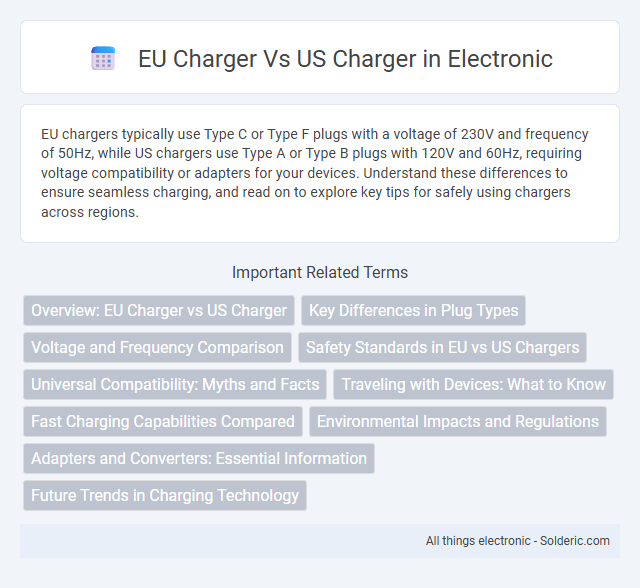EU chargers typically use Type C or Type F plugs with a voltage of 230V and frequency of 50Hz, while US chargers use Type A or Type B plugs with 120V and 60Hz, requiring voltage compatibility or adapters for your devices. Understand these differences to ensure seamless charging, and read on to explore key tips for safely using chargers across regions.
Comparison Table
| Feature | EU Charger | US Charger |
|---|---|---|
| Plug Type | Type C, Type E/F | Type A, Type B |
| Voltage | 220-240 V | 110-120 V |
| Frequency | 50 Hz | 60 Hz |
| Power Output | Typically 10-25 W (phone chargers) | Typically 5-20 W (phone chargers) |
| Safety Features | Built-in fuse, overvoltage protection | Built-in fuse, surge protection |
| Compatibility | Works in EU and compatible countries | Works in US and compatible countries |
| Certification | CE Marking | UL Certification |
| Adapter Requirement | Required for US plugs | Required for EU plugs |
Overview: EU Charger vs US Charger
The EU charger uses a Type C or Type F plug with a standard voltage of 230V and frequency of 50Hz, while the US charger employs Type A or Type B plugs with a standard voltage of 120V and frequency of 60Hz. EU chargers generally support higher wattage due to the higher voltage, which affects charging speed and compatibility with devices primarily designed for American electrical standards. Power adapters and plug converters are necessary when using chargers between these regions to ensure safe and efficient device charging.
Key Differences in Plug Types
EU chargers primarily use Type C and Type F plugs featuring two round pins, designed for 220-240V electrical systems, while US chargers utilize Type A and Type B plugs with flat parallel pins suited for 110-120V systems. The EU plug's grounding pin and thicker prongs provide enhanced safety and compatibility with high voltage, whereas the US plug's grounding pin is optional and the prongs are thinner, reflecting differences in electrical standards. These variations impact device compatibility, requiring plug adapters or voltage converters for cross-region usage.
Voltage and Frequency Comparison
European chargers typically operate at 220-240 volts with a frequency of 50 Hz, while US chargers run on 100-120 volts at 60 Hz. This voltage and frequency difference affects compatibility and charging efficiency, requiring plug adapters or voltage converters when using devices across regions. Manufacturers often design chargers with dual voltage capabilities to accommodate this variation and ensure safe, efficient charging worldwide.
Safety Standards in EU vs US Chargers
EU chargers adhere to stringent safety standards such as the CE marking and RoHS compliance, ensuring rigorous testing for electrical safety, electromagnetic compatibility, and environmental impact. US chargers follow UL certification and FCC regulations, focusing on protecting against electrical hazards and radio frequency interference. Understanding these differences helps you choose chargers that meet the highest safety benchmarks for your devices.
Universal Compatibility: Myths and Facts
EU chargers often use Type C or Type F plugs operating at 220-240V and 50Hz, while US chargers utilize Type A or Type B plugs with 110-120V and 60Hz, affecting universal compatibility. Many think EU and US chargers are mutually exclusive, but most modern USB chargers have built-in voltage converters supporting 100-240V input, enabling use across regions with the correct plug adapter. You can safely use your device internationally by verifying charger specifications and acquiring the appropriate plug adapter.
Traveling with Devices: What to Know
EU chargers typically operate at 220-240 volts with a frequency of 50 Hz, while US chargers run on 110-120 volts at 60 Hz, affecting device compatibility when traveling. Most modern electronic devices support dual voltage (100-240V), but using a plug adapter is necessary to fit the different socket types: Type C or F in Europe versus Type A or B in the US. Travelers should verify device voltage ratings and consider voltage converters or dual voltage chargers to prevent damage and ensure safe charging abroad.
Fast Charging Capabilities Compared
EU chargers typically offer higher wattage outputs and utilize the USB Power Delivery (USB-PD) standard, enabling faster charging speeds for compatible devices compared to many US chargers, which still often rely on older standards like Qualcomm Quick Charge or lower wattage ratings. The 230V electrical system in the EU supports efficient power delivery, allowing your devices to charge more rapidly with properly rated EU chargers. Understanding these differences helps optimize your charging setup, especially when using devices designed for fast charging in different regions.
Environmental Impacts and Regulations
EU chargers adhere to strict environmental regulations, such as the EU's Ecodesign Directive, which mandates energy efficiency and limits hazardous substances, significantly reducing electronic waste and carbon footprint. US chargers face less uniform regulatory standards, often resulting in higher energy consumption and more abundant non-compliant devices that contribute to environmental degradation. Ensuring your devices use EU-compliant chargers promotes sustainability through reduced emissions and supports global efforts to minimize electronic waste.
Adapters and Converters: Essential Information
EU chargers typically operate at 220-240 volts with Type C or Type F plugs, while US chargers use 110-120 volts with Type A or Type B plugs. Your devices may require a voltage converter or plug adapter to function safely when moving between these regions, as incompatible voltages can damage electronics. Using the correct adapter ensures your device receives the proper current, preventing electrical hazards and maintaining performance.
Future Trends in Charging Technology
Future trends in charging technology highlight the shift towards universal standards, with the European Union aggressively promoting USB-C adoption to reduce electronic waste and improve device compatibility. In contrast, the US market continues to rely heavily on proprietary solutions, although regulatory pressure is increasing to align with global norms. Advances in wireless and ultra-fast charging methods are expected to dominate both regions, enhancing user convenience while supporting sustainability goals.
EU charger vs US charger Infographic

 solderic.com
solderic.com